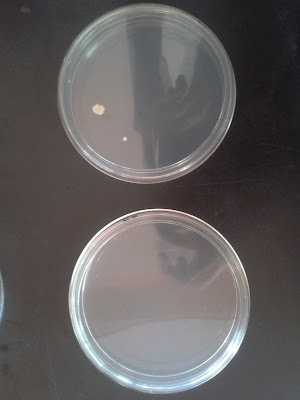Matric no. : 111427
Introduction
Airborne microorganisms are usually carried on dust particles, although some may be carried directly by air currents (for example,fungal spores). It is important for microbiologists to be aware of the potential for contamination by airborne microorganisms. Carefully observation of simple precaution reduces the risk of contamination of the cultures.
Every human is colonized by billions of microorganisms. These microorganisms, some of them are vital to our wellbeing, constitute our resident or normal microflora. Resident microorganisms are nourished by the chemicals and moisture excreted by the human body. In moist areas such as armpit, there may be one million bacteria per cm^3; on the drier skin of the forearm, there may be 10000 bacteria per cm^3.
Resident microorganisms are either nonpathogenic or are prevented from infecting the body by an array of mechanical and chemical defences. Some resident microbes are, however, opportunistic pathogens which may cause infection if the body's defences are breached. For example, if the skin is broken.
Transient microorganisms are picked up from our environment. For example, from faecal contact or from soil and usually fail to become permanent skin residents. One of the most important reasons for failure to gain permanence is that the established residents are better able to compete for nutrients. Since transients generally originate in other environments, they are poorly adapted to conditions on the skin and usually disappear within 24 hours of arrival.
Microorganisms in the upper respiratory tract are either normal residents or transients. As with the skin, the normal microflora are largely consists of nonpathogen or opportunistic pathogens.
Large numbers of transients enter the upper respiratory tract as we breathe or eat. They may also come from our own hands or or from improper sanitation during food preparation. Regardless of their origin, most transients are nonpathogenic and are quickly killed by various defences arrayed against them.
Objective
To determine the microorganisms in the air and from healthy humans.
Results
1) Colonies in air :
2) Colonies of hands :
3) Colonies of ear:
4) Colonies of normal breathing :
5) Coloniesof violent coughing :
Discussion
Type of microorganisms
1) Bacteria:
Bacteria are a large domain of prokaryotic ( simpler structures than eukaryotes) microrganisms. Typically a few micrometer in length, bacteria have a wide range of shapes, ranging from spheres to rods and spirals. Bacteria do not have a nucleus and contain 2 major components (cytoplasm and cell envelope). It reproduce via binary fission. Frequently shiny and smooth in appearance.
2) Fungi:
A fungus is a member of a large group of eukaryotic organisms that includes microorganisms such as yeasts and molds, as well as the more familiar mushrooms.Do not differentiate into roots, stems and leaves. The true fungi produce masses of filamentous hyphae which form the mycelium. Some are rough, dull, wrinkled. Usually filamentous in shape.
3) Virus:
A virus is a small infectious agent that can replicate only inside the living cells of organisms.Extremely small parasites. Require living cells of plants, animals, or bacteria as hosts for growth. Mainly a packet of genetic material which must be reproduced by the host. Virus is extremely small and cannot be seen through naked eye.
4) Algae:
Algae are a large and diverse group of simple, typically autotrophic organisms, ranging from unicellular to multicellular forms. Range from 1 micrometer diameter to 60 m long. They are different sizes, one cell, two or more cells, millions of cells. Algae can be filamentous, parenchymatous, coenocytic, flagellates, coccoid, capsoid.
5) Protozoa:
Protozoa are a diverse group of unicellular eukaryotic organisms such as ameoba,many of which are motile. They possess cell structure similar to higher, more complex organisms. They reproduce via fission.They are small organisms,
ranging from a few microns in length up to about 1 mm.
Sources of contamination
1) Air:Microorganisms present in air are vegetative cells and spores of bacteria, fungi and algae, viruses and protozoa.Since air is often exposed to sunlight, it has a higher temperature and less moisture. Hence, most of these microbial forms will die.
2) Hands:
Skin variety provides a rich and diverse habitat for bacteria. Staphylococcus epidermidis is one type of a thousand bacteria species present on human skin. They usually not pathogenic, but it can cause skin infection. The other bacteria present in human skin is Staphylococcus aureus. They forms
a fairly large yellow colony on rich medium.
3) Ear:
The outer ear is home to a varied collection of bacteria, yeasts and molds. Bacteria cause most ear infection. The most common types are Streptococcus pneumoniae,
Haemophilus influenzae, and Moraxella catarrhalis.
4) Normal breathing:
The nasal passageway is close to other niches like the lungs, mouth, and
throat. The nasal passage is influenced by the bacteria colonies of Staphylococcus aureus. Successful colonization depends not only on the ability of S. aureus
to survive host factors but also on coexistence with other bacteria. An
airborne bacterium also causes allergies and irritation. Another microorganisms are Streptococcus pneumoniae which present in
the upper
respiratory
tract of about half the population.
5) Violent coughing:
The healthy human mouth is home to a tremendous variety of microbes including viruses, fungi, protozoa and bacteria. The bacteria are the most numerous. Though bacteria and saliva can be beneficial to one’s health, both can
also cause problems. Many diseases are related to oral bacteria. Oral bacteria include streptococci, lactobacilli, staphylococci, corynebacteria, and various anaerobes in particular bacteroids.
Conclusion
Microorganisms are bacteria,fungi, algae,virus and protozoa. These types of microorganisms can be found in air and also from all living things such as humans and animals whenever there are suitable condition for them to growth.
References
1) http://en.wikipedia.org/wiki/Bacteria
2) http://biology.clc.uc.edu/fankhauser/Labs/Microbiology/Bacterial_Morphology/Bacterial_Morphology.htm
3) http://en.wikipedia.org/wiki/Fungus
4) http://en.wikipedia.org/wiki/Virus
5) http://en.wikipedia.org/wiki/Algae
6) http://www.webmd.com/cold-and-flu/ear-infection/ear-infections-cause
7) http://microbewiki.kenyon.edu/index.php/Nasal_passageway
8) http://www.sciencedaily.com/releases/2008/08/080810214006.htm
9) http://www.biology.ualberta.ca/parasites/parpub/text/text/proto01b.htm
10) http://en.wikipedia.org/wiki/Oral_microbiology





No comments:
Post a Comment